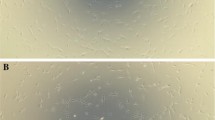Abstract
Platelet-rich plasma is widely used in acute and chronic ulcers due to its capacity to enhance the wound healing process. Fibroblasts are believed to be the most important cells in the production and remodeling of the extracellular matrix (ECM). Matrix metalloproteinase (MMP)-1 is the proteolytic enzyme of collagen I, and has a key role in collagen remodeling during wound healing. Whether or not platelet-rich clot releasate (PRCR) is able to effectively modulate the ECM, and the effect of PRCR on the expression of type I collagen and MMP-1 in human dermal fibroblasts was evaluated. Specifically, human adult dermal fibroblasts were incubated in PRCR-containing solutions for 24 and 48 h, after which the levels of collagen and MMP-1 were quantified by reverse transcription PCR at the transcriptional level, and ELISA and immunoblot analyses at the post-transcriptional level. PRCR markedly up-regulated the expression of MMP-1 and type I collagen in fibroblasts incubated in 20 % PRCR solutions for 48 h. These findings suggest that increased MMP-1 expression after PRCR treatment enable remodeling the ECM.



Similar content being viewed by others
References
Mutsaers SE, Bishop JE, McGrouther G, Laurent GJ (1997) Mechanisms of tissue repair: from wound healing to fibrosis. Int J Biochem Cell Biol 29:5–17
Kirsner RS, Eaglstein WH (1993) The wound healing process. Dermatol Clin 11:629–640
Harrison P, Cramer EM (1993) Platelet alpha-granules. Blood Rev 7:52–62
Kondo T, Ohshima T (1996) The dynamics of inflammatory cytokines in the healing process of mouse skin wound: a preliminary study for possible wound age determination. Int J Legal Med 108:231–236
Moulin V (1995) Growth factors in skin wound healing. Eur J Cell Biol 68:1–7
Welgus HG, Jeffrey JJ, Eisen AZ (1981) The collagen substrate specificity of human skin fibroblast collagenase. J Biol Chem 256:9511–9515
Zhang J, Wang JH (2010) Platelet-rich plasma releasate promotes differentiation of tendon stem cells into active tenocytes. Am J Sports Med 38:2477–2486
Chen L, Dong SW, Tao X, Liu JP, Tang KL, Xu JZ (2012) Autologous platelet-rich clot releasate stimulates proliferation and inhibits differentiation of adult rat tendon stem cells towards nontenocyte lineages. J Int Med Res 40:1399–1409
Bosman FT, Stamenkovic I (2003) Functional structure and composition of the extracellular matrix. J Pathol 200:423–428
Birkedal-Hansen H, Moore WG, Bodden MK et al (1993) Matrix metalloproteinases: a review. Crit Rev Oral Biol Med 4:197–250
Peled ZM, Phelps ED, Updike DL et al (2002) Matrix metalloproteinases and the ontogeny of scarless repair: the other side of the wound healing balance. Plast Reconstr Surg 110:801–811
Gu Q, Wang D, Gao Y et al (2002) Expression of MMP1 in surgical and radiation-impaired wound healing and its effects on the healing process. J Environ Pathol Toxicol Oncol 21:71–78
Xie J, Bian H, Qi S et al (2008) Effects of basic fibroblast growth factor on the expression of extracellular matrix and matrix metalloproteinase-1 in wound healing. Clin Exp Dermatol 33:176–182
Gomez DE, Alonso DF, Yoshiji H, Thorgeirsson UP (1997) Tissue inhibitors of metalloproteinases: structure, regulation and biological functions. Eur J Cell Biol 74:111–122
Reynolds JJ (1996) Collagenases and tissue inhibitors of metalloproteinases: a functional balance in tissue degradation. Oral Dis 2:70–76
Aiba-Kojima E, Tsuno NH, Inoue K et al (2007) Characterization of wound drainage fluids as a source of soluble factors associated with wound healing: comparison with platelet-rich plasma and potential use in cell culture. Wound Repair Regen 15:511–520
Anitua E, Sanchez M, Zalduendo MM et al (2009) Fibroblastic response to treatment with different preparations rich in growth factors. Cell Prolif 42:162–170
Liu Y, Kalen A, Risto O, Wahlstrom O (2002) Fibroblast proliferation due to exposure to a platelet concentrate in vitro is pH dependent. Wound Repair Regen 10:336–340
Graziani F, Ivanovski S, Cei S et al (2006) The in vitro effect of different PRP concentrations on osteoblasts and fibroblasts. Clin Oral Implants Res 17:212–219
Colige A, Nusgens B, Lapiere CM (1988) Effect of EGF on human skin fibroblasts is modulated by the extracellular matrix. Arch Dermatol Res 280(Suppl):S42–S46
Visser LC, Arnoczky SP, Caballero O et al (2010) Growth factor-rich plasma increases tendon cell proliferation and matrix synthesis on a synthetic scaffold: an in vitro study. Tissue Eng Part A 16:1021–1029
Umeno Y, Okuda A, Kimura G (1989) Proliferative behaviour of fibroblasts in plasma-rich culture medium. J Cell Sci 94(Pt 3):567–575
Inagaki Y, Truter S, Ramirez F (1994) Transforming growth factor-beta stimulates alpha 2(I) collagen gene expression through a cis-acting element that contains an Sp1-binding site. J Biol Chem 269:14828–14834
Roberts AB, Sporn MB, Assoian RK et al (1986) Transforming growth factor type beta: rapid induction of fibrosis and angiogenesis in vivo and stimulation of collagen formation in vitro. Proc Natl Acad Sci USA 83:4167–4171
Ivarsson M, McWhirter A, Borg TK, Rubin K (1998) Type I collagen synthesis in cultured human fibroblasts: regulation by cell spreading, platelet-derived growth factor and interactions with collagen fibers. Matrix Biol 16:409–425
Tan EM, Rouda S, Greenbaum SS et al (1993) Acidic and basic fibroblast growth factors down-regulate collagen gene expression in keloid fibroblasts. Am J Pathol 142:463–470
de Mos M, van der Windt AE, Jahr H et al (2008) Can platelet-rich plasma enhance tendon repair? A cell culture study. Am J Sports Med 36:1171–1178
Author information
Authors and Affiliations
Corresponding author
Rights and permissions
About this article
Cite this article
Shin, M.K., Lee, J.W., Kim, Y.I. et al. The effects of platelet-rich clot releasate on the expression of MMP-1 and type I collagen in human adult dermal fibroblasts: PRP is a stronger MMP-1 stimulator. Mol Biol Rep 41, 3–8 (2014). https://doi.org/10.1007/s11033-013-2718-9
Received:
Accepted:
Published:
Issue Date:
DOI: https://doi.org/10.1007/s11033-013-2718-9



